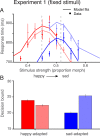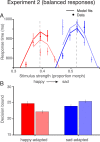Sensory and decision-making processes underlying perceptual adaptation
- PMID: 30140892
- PMCID: PMC6108310
- DOI: 10.1167/18.8.10
Sensory and decision-making processes underlying perceptual adaptation
Abstract
Perceptual systems adapt to their inputs. As a result, prolonged exposure to particular stimuli alters judgments about subsequent stimuli. This phenomenon is commonly assumed to be sensory in origin. Changes in the decision-making process, however, may also be a component of adaptation. Here, we quantify sensory and decision-making contributions to adaptation in a facial expression paradigm. As expected, exposure to happy or sad expressions shifts the psychometric function toward the adaptor. More surprisingly, response times show both an overall decline and an asymmetry, with faster responses opposite the adapting category, implicating a substantial change in the decision-making process. Specifically, we infer that sensory changes from adaptation are accompanied by changes in how much sensory information is accumulated for the two choices. We speculate that adaptation influences implicit expectations about the stimuli one will encounter, causing modifications in the decision-making process as part of a normative response to a change in context.
Figures









Similar articles
-
Adaptive History Biases Result from Confidence-Weighted Accumulation of past Choices.J Neurosci. 2018 Mar 7;38(10):2418-2429. doi: 10.1523/JNEUROSCI.2189-17.2017. Epub 2018 Jan 25. J Neurosci. 2018. PMID: 29371318 Free PMC article.
-
Perceptual Decision-Making as Probabilistic Inference by Neural Sampling.Neuron. 2016 May 4;90(3):649-60. doi: 10.1016/j.neuron.2016.03.020. Epub 2016 Apr 14. Neuron. 2016. PMID: 27146267
-
Amygdala mediated connectivity in perceptual decision-making of emotional facial expressions.Brain Connect. 2013;3(4):386-97. doi: 10.1089/brain.2013.0145. Brain Connect. 2013. PMID: 23705655
-
Decision-related activity in sensory neurons: correlations among neurons and with behavior.Annu Rev Neurosci. 2012;35:463-83. doi: 10.1146/annurev-neuro-062111-150403. Epub 2012 Apr 5. Annu Rev Neurosci. 2012. PMID: 22483043 Review.
-
How mechanisms of perceptual decision-making affect the psychometric function.Prog Neurobiol. 2013 Apr;103:98-114. doi: 10.1016/j.pneurobio.2012.05.008. Epub 2012 May 17. Prog Neurobiol. 2013. PMID: 22609483 Free PMC article. Review.
Cited by
-
Confidence as a diagnostic tool for perceptual aftereffects.Sci Rep. 2019 May 9;9(1):7124. doi: 10.1038/s41598-019-43170-1. Sci Rep. 2019. PMID: 31073187 Free PMC article.
-
Dynamics of sensory and decisional biases in perceptual decision making: Insights from the face distortion illusion.Psychon Bull Rev. 2025 Feb;32(1):317-325. doi: 10.3758/s13423-024-02539-8. Epub 2024 Jul 9. Psychon Bull Rev. 2025. PMID: 38980570
-
Adaptation aftereffects reveal how categorization training changes the encoding of face identity.J Vis. 2020 Oct 1;20(10):18. doi: 10.1167/jov.20.10.18. J Vis. 2020. PMID: 33064122 Free PMC article.
-
How positive emotional content overrules perceptual history effects: Hysteresis in emotion recognition.J Vis. 2020 Aug 3;20(8):19. doi: 10.1167/jov.20.8.19. J Vis. 2020. PMID: 32805042 Free PMC article.
-
Positive hysteresis in emotion recognition: Face processing visual regions are involved in perceptual persistence, which mediates interactions between anterior insula and medial prefrontal cortex.Cogn Affect Behav Neurosci. 2022 Dec;22(6):1275-1289. doi: 10.3758/s13415-022-01024-w. Epub 2022 Jul 20. Cogn Affect Behav Neurosci. 2022. PMID: 35857280 Free PMC article.
References
Publication types
MeSH terms
Grants and funding
LinkOut - more resources
Full Text Sources
Other Literature Sources
Research Materials

